Maintaining the electrical system in your 2000 Ford Ranger is crucial for its overall performance and safety. Fuses are essential components that protect your vehicle’s electrical circuits from damage caused by overloads. When electrical parts in your 2000 Ford Ranger stop working, a blown fuse is often the culprit. This comprehensive 2000 Ford Ranger Fuse Guide will help you locate, identify, check, and replace fuses in your vehicle, ensuring your electrical system runs smoothly.
Before attempting any electrical repairs, understanding your 2000 Ford Ranger fuse layout is the first step. This guide provides detailed fuse box diagrams and information to assist you in troubleshooting and resolving electrical issues.
Passenger Compartment Fuse Panel
The passenger compartment fuse panel in your 2000 Ford Ranger is conveniently located inside the vehicle. This panel houses fuses that protect circuits for various interior electrical components.
The diagram below illustrates the layout and fuse designations for the passenger compartment fuse box in 1998-2000 Ford Ranger models.
| No. | AMPS | Circuits protected |
|---|---|---|
| 1 | 7.5 | Power Mirror Switch |
| 2 | 7.5 | Blower Motor Relay, PAD Module, Air Bag Diagnostic Monitor |
| 3 | 7.5 | Left Stop/Turn Trailer Tow Connector |
| 4 | 10 | Left Headlamp |
| 5 | 10 | 1998-1999: Data Link Connector (DLC) |
| 6 | 15 | 2000: Overdrive, Back-up Lamps, DRL, 4×4 |
| 7 | 7.5 | Right Stop/Turn Trailer Tow Connector |
| 8 | 10 | Right Headlamp, Fog Lamp Relay |
| 9 | 7.5 | Brake Pedal Position Switch |
| 10 | 7.5 | Speed Control Servo/Amplifier Assembly, Generic Electronic Module (GEM), Shift Lock Actuator, Blend Door Actuator, A/C-Heater Assembly, Turn Signals |
| 11 | 7.5 | Instrument Cluster, Daytime Running Lights (DRL), RABS Resistor |
| 12 | — | Not Used |
| 13 | 20 | Brake Pedal Position Switch |
| 14 | 20 | Rear Anti-Lock Brake System (RABS) Module |
| 10 | 4 Wheel Anti-Lock Brake System (4WABS) Module, 4WABS Main Relay | |
| 15 | 7.5 | Air Bag Indicator Lamp, Alternator Indicator Lamp, Instrument Cluster |
| 16 | 30 | Windshield Wiper Motor, Wiper Hi-Lo Relay, Wiper Run/Park Relay |
| 17 | 25 | Cigar Lighter, Data Link Connector (DLC; 2000) |
| 18 | 15 | Driver’s Unlock Relay, All-Unlock Relay, All-Lock Relay |
| 19 | 25 | PCM Power Diode, Ignition, PATS |
| 20 | 7.5 | RAP Module, Generic Electronic Module (GEM), Radio |
| 21 | 15 | Flasher (Hazard) |
| 22 | 20 | Auxiliary Power Socket |
| 23 | — | Not Used |
| 24 | 7.5 | Clutch Pedal Position (CPP) switch, Starter Interrupt Relay, Anti-Theft |
| 25 | 7.5 | 1998-1999: Generic Electronic Module (GEM), Instrument Cluster |
| 26 | 10 | Battery Saver Relay, Electronic Shift Relay, Interior Lamp Relay, Power Window Relay, Electronic Shift Control Module, Dome/Map Lamp, GEM, Instrument Cluster (2000) |
| 27 | 15 | 1998-1999: Electric Shift, Backup Lamps, Daytime Running Lamps (DRL), Transmission Control Switch, Pulse Vacuum Hub Lock |
| 28 | 7.5 | Generic Electronic Module (GEM), Radio |
| 29 | 15 | Radio |
| 30 | 10 | 1999-2000: RABS Test Connector |
| 15 | 1998: Park Lamp/Trailer Tow Relay | |
| 31 | — | Not Used |
| 32 | — | Not Used |
| 33 | 15 | Headlamps, Daytime Running Lamps (DRL) Module, Instrument Cluster |
| 34 | — | Not Used |
| 35 | 15 | 1999: Park Lamp/Trailer Tow Relay |
| 10 | 1998: RABS Test Connector | |
| 36 | — | Not Used |
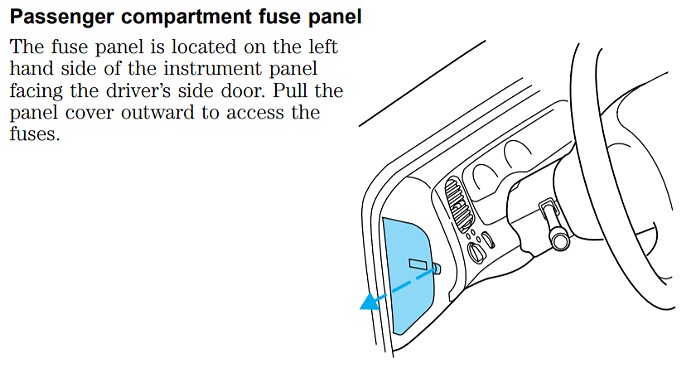
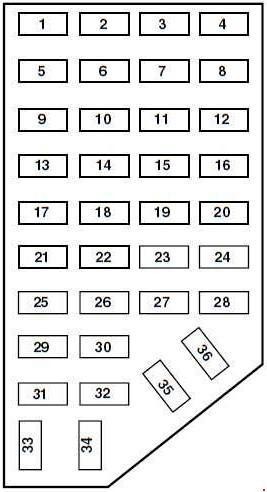
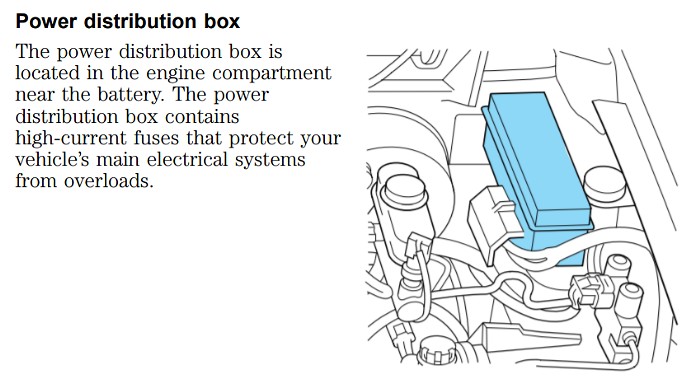
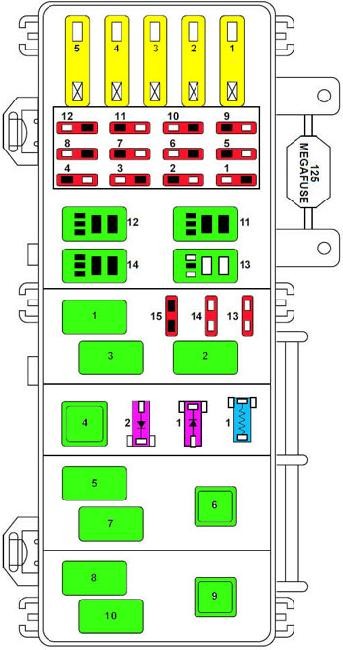
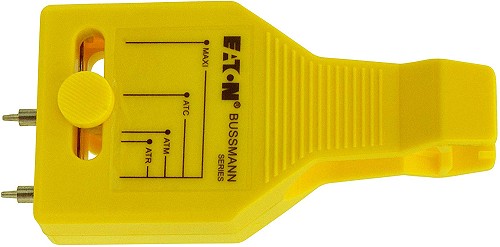
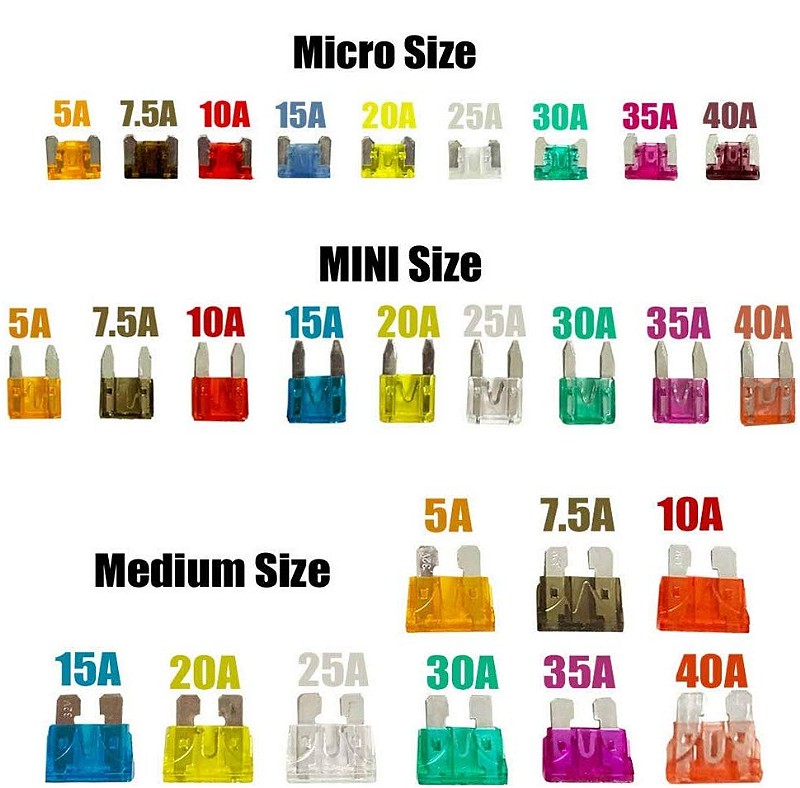
Power Distribution Box
For components in the engine bay and other high-power systems, the 2000 Ford Ranger utilizes a power distribution box. This box is located in the engine compartment and contains fuses and relays for critical vehicle functions.
The power distribution box in a 2000 Ford Ranger is typically found on the driver’s side of the engine compartment, near the fender.
| No. | AMPS | Circuits protected |
|---|---|---|
| 1 | 50 | I/P Fuse Panel |
| 2 | 40 | Blower Motor Relay |
| 3 | 50 | 4 Wheel Anti-Lock Brake System (4WABS) Module |
| 4 | 20 | Power Windows |
| 5 | 50 | Ignition Switch, Starter Relay |
| 1 | 10 | A/C Relay |
| 2 | 20 | Auxiliary Power Point |
| 3 | 20 | Electronic Shift Relay and Electronic Shift Control Module |
| 4 | 20 | 2000: Fog Lamp and Daytime Running Lamps |
| 15 | 1998-1999: Fog Lamp and Daytime Running Lamps | |
| 5 | 15 | 2000: Trailer Tow Park Lamps |
| 10 | 1998: Air Bag Diagnostic Monitor | |
| 6 | 10 | Powertrain Control Module |
| 7 | 30 | 4 Wheel Anti-lock Brake System (4WABS) Module |
| 8 | 30 | PCM Relay |
| 9 | 20 | Fuel Pump Relay and RAP Module |
| 10 | 15 | Horn Relay |
| 11 | 15 | Parklamps Relay and Main Light Switch |
| 12 | 30 | Mam Light Switch and Multifunction Switch |
| 13 | 15 | Heated Oxygen Sensor, EGR Vacuum Regulator, EVR Solenoid, Camshaft Position Sensor (CMP), Canister Vent Solenoid |
| 14 | 30 | Alternator Voltage Regulator |
| 15 | — | Not Used |
| 1 | Wiper Park Relay | |
| 2 | A/C Relay | |
| 3 | Wiper Hi/Lo Relay | |
| 4 | PCM Power Relay | |
| 5 | Fuel Pump Relay | |
| 6 | Starter Relay | |
| 7 | Horn Relay | |
| 8 | 1999-2000: Fog Lamp Control Relay 1998: Washer Pump Relay | |
| 9 | Blower Motor Relay | |
| 10 | 1999-2000: Foglamp Isolation Relay 1998: Foglamp Relay | |
| 11 | Not Used | |
| 12 | Not Used | |
| 13 | Park Lamp/Trailer Tow Relay | |
| 14 | Washer Pump Relay | |
| 1 | RABS Resistor | |
| 1 | RABS Diode | |
| 2 | Electronic Engine Controls Diode |
Step-by-Step Guide: Checking and Replacing Fuses in Your 2000 Ford Ranger
When an electrical component in your 2000 Ford Ranger malfunctions, checking the fuses should be one of your first troubleshooting steps. Here’s how to check and replace fuses effectively:
-
Locate the Fuse Panels:
- Passenger Compartment Fuse Panel: This panel is situated on the left end of the instrument panel inside your 2000 Ford Ranger. Access it by removing the cover. You can typically do this by inserting your finger into the provided divot and gently pulling the cover off.
- Power Distribution Box: As previously mentioned, the power distribution box is located in the engine compartment on the driver’s side, mounted to the fender.
-
Identify the Fuse to Check:
- Refer to the fuse panel diagrams provided earlier in this 2000 Ford Ranger fuse guide or the diagram usually found on the inside of the fuse panel cover. Locate the fuse number that corresponds to the circuit you suspect is having issues.
-
Inspect the Fuse:
-
Visually examine the fuse. Look through the clear plastic casing to see the metal wire inside. If the wire is broken or melted, the fuse is blown and needs replacement.
-
Fuse Tester Method (Optional): For a more convenient check, use a Bussmann fuse tester (or similar fuse testing tool). This allows you to test the fuse without removing it. Simply align the tester prongs with the metal test points on top of the fuse. If the indicator light illuminates, the fuse is good. If not, it’s likely blown.
-
-
Replace the Blown Fuse:
- If you’ve confirmed a blown fuse, it’s time to replace it. Use the fuse pulling tool, often found in the passenger compartment fuse panel, to gently remove the blown fuse.
- Crucially, always replace a blown fuse with a new fuse of the exact same amperage rating. The amperage rating is printed on the fuse and is also indicated by its color. Using a fuse with a higher amperage rating can overload the circuit and cause significant wire damage or even a fire.
-
Install the New Fuse and Test:
- Press the new fuse firmly into the fuse slot until it is fully seated.
- Turn the ignition to the ON position and test the electrical component that was malfunctioning to see if it now works.
-
Replace Fuse Panel Cover:
- Once you’ve replaced the fuse and confirmed the circuit is working, reinstall the fuse panel cover securely.
-
Troubleshooting Persistent Fuse Issues:
- If a newly replaced fuse blows immediately or shortly after replacement, this indicates a persistent problem in the circuit. There may be a short circuit or an overload condition. In such cases, it’s recommended to have your 2000 Ford Ranger’s electrical system professionally inspected by a qualified mechanic.
Understanding Fuse Colors and Amperage Ratings
Automotive fuses are color-coded to easily identify their amperage ratings. This standardization is critical for ensuring you use the correct replacement fuse. Always match the color and amperage when replacing a fuse in your 2000 Ford Ranger.
Refer to the image above for common fuse colors and their corresponding amperage ratings. Spare fuses of different amperage ratings are often stored in the passenger compartment fuse panel for your convenience.
By using this 2000 Ford Ranger fuse guide, you can confidently maintain your vehicle’s electrical system, diagnose fuse-related issues, and ensure your 2000 Ford Ranger remains reliable. Remember, proper fuse maintenance is a key aspect of vehicle care and safety.
